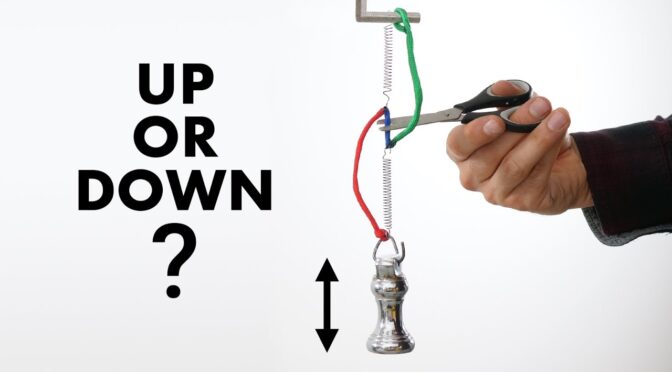Based on the video titled “The Spring Paradox” by Steve Mould, this article aims to elucidate the perplexing behavior of springs and ropes when subjected to certain conditions, and how this seemingly simple mechanical setup serves as an analogy for a traffic-based paradox known as Braess’s Paradox.
Contents
- The Spring Setup and Its Puzzling Behavior
- Analogy to Braess’s Paradox
- The Human Factor in Traffic Optimization
- The video
- Real-world Applications of Braess’s Paradox
- The Role of Technology in Traffic Optimization
The Spring Setup and Its Puzzling Behavior
In the video, Steve Mould presents an arrangement of springs and ropes with a weight at the bottom. When the blue rope connecting two springs is cut, the weight surprisingly moves upward instead of downward. The reason for this counterintuitive behavior lies in the transition from having two springs in series to two springs in parallel. When the springs are in series, they extend twice as far as a single spring would, taking on the entire weight. Cutting the blue rope changes the setup to two springs in parallel, each taking half the weight, causing the weight to rise.
Analogy to Braess’s Paradox
The spring setup serves as an analogy for Braess’s Paradox in traffic flow. Imagine two towns connected by a network of roads. Some roads are wide and take a fixed amount of time to traverse, while others are narrow and get congested. When a new, fast road (analogous to the blue rope) is introduced, it seems logical to assume that travel time between the towns would decrease. However, the paradox reveals that removing this new road can actually reduce overall travel time. This is because drivers redistribute themselves among the remaining roads, reducing congestion and travel time.
The Human Factor in Traffic Optimization
While the spring setup and Braess’s Paradox provide valuable insights into system optimization, the human element introduces complexity. Even if self-driving cars programmed to cooperate become prevalent, the presence of a human in the car, ready to override the system for a faster route, complicates the ideal of a fully optimized traffic network.
The video
Real-world Applications of Braess’s Paradox
Braess’s Paradox isn’t just a theoretical construct; it has real-world implications in urban planning and traffic management. For instance, cities like Seoul and Stuttgart have experienced reduced travel times after the removal of certain roads. This paradox can serve as a guide for city planners to reevaluate the efficiency of existing road networks and consider unconventional solutions like road removal for better traffic flow.
The Role of Technology in Traffic Optimization
Advancements in technology, particularly the rise of self-driving cars, could potentially solve the human-induced complexities in Braess’s Paradox. If self-driving cars, programmed to cooperate and optimize traffic flow, become the majority on the roads, we could move closer to a more efficient transportation system. However, the technology must overcome challenges such as human override functions and varying software protocols among different car manufacturers.

